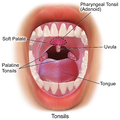Tonsil
| Tonsil | |
|---|---|
 | |
 Sagittal view of tonsils and throat anatomy | |
| Details | |
| System | Immune system Lymphatic system |
| Identifiers | |
| Latin | tonsilla, tonsillae (pl.) |
| TA98 | A05.2.01.011 |
| FMA | 9609 |
| Anatomical terminology | |
The tonsils are a set of
When used unqualified, the term most commonly refers specifically to the palatine tonsils, which are two lymphoid organs situated at either side of the back of the human throat. The palatine tonsils and the adenoid tonsil are organs consisting of lymphoepithelial tissue located near the
Structure
Humans are born with four types of tonsils: the pharyngeal tonsil, two tubal tonsils, two palatine tonsils and the lingual tonsils.[1]
| Type | Epithelium | Capsule | Crypts | Location |
|---|---|---|---|---|
| Pharyngeal tonsil (also termed "adenoid") | Ciliated pseudostratified columnar (respiratory epithelium ) |
Incompletely encapsulated | Small folds—sometimes described as crypts[2] | Roof of pharynx |
Tubal tonsils |
Ciliated pseudostratified columnar (respiratory epithelium) | Roof of pharynx | ||
Palatine tonsils |
Non-keratinized stratified squamous | Incompletely encapsulated | Long, branched[3] | Sides of oropharynx between palatoglossaland palatopharyngeal arches |
| Lingual tonsils | Non-keratinized stratified squamous | Incompletely encapsulated | Long, unbranched[3][4] | Behind terminal sulcus (tongue)
|
Development
The palatine tonsils tend to reach their largest size in puberty, and they gradually undergo atrophy thereafter. However, they are largest relative to the diameter of the throat in young children. In adults, each palatine tonsil normally measures up to 2.5 cm in length, 2.0 cm in width and 1.2 cm in thickness.[5]
The adenoid grows until the age of 5, starts to shrink at the age of 7 and becomes small in adulthood.[medical citation needed]
Function
The tonsils are immunocompetent organs that serve as the immune system's first line of defense against ingested or inhaled foreign pathogens, and as such frequently engorge with blood to assist in immune responses to common illnesses such as the common cold. The tonsils have on their surface specialized antigen capture cells called microfold cells (M cells) that allow for the uptake of antigens produced by pathogens. These M cells then alert the B cells and T cells in the tonsil that a pathogen is present and an immune response is stimulated.[6] B cells are activated and proliferate in areas called germinal centers in the tonsil. These germinal centers are places where B memory cells are created and secretory antibody (IgA) is produced.
Clinical significance

The palatine tonsils can become enlarged (adenotonsillar
A
Palatine tonsil enlargement can affect speech, making it
As mucosal lymphatic tissue of the aerodigestive tract, the palatine tonsils are viewed in some classifications as belonging to both the gut-associated lymphoid tissue (GALT) and the mucosa-associated lymphoid tissue (MALT). Other viewpoints treat them (and the spleen and thymus) as large lymphatic organs contradistinguished from the smaller tissue loci of GALT and MALT.
Additional images
-
Illustration of frontal view of tonsils
References
- ^ "Definitive pharynx; Thyroid; Middle ear; Tonsils; Thymus". www.embryology.ch. Archived from the original on 22 November 2010. Retrieved 2018-10-15.
- PMID 30801022.
- ^ a b "The Lymphatic System". act.downstate.edu. Archived from the original on 2017-02-02. Retrieved 2017-01-29.
- ^ Shahid S. "Tonsils". Ken Hub. Retrieved 2023-01-17.
- ISBN 9781447133322.
- PMID 23540615.
- ^ "Tonsils | Tonsilitis | Lymph Nodes". MedlinePlus. U.S. National Library of Medicine. Retrieved 2017-01-29.
- PMID 22297210.
- ^ "Tonsil Stones Removal – What Are Tonsil Stones and How We Can Treat Them - eLimpid". elimpid.com. 2023-05-06. Retrieved 2023-05-11.
- PMID 18468843.
- S2CID 42924590.
External links
 Media related to Tonsils at Wikimedia Commons
Media related to Tonsils at Wikimedia Commons

